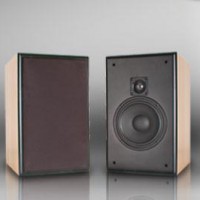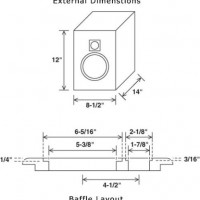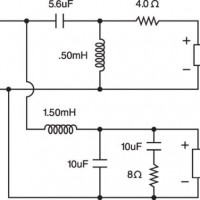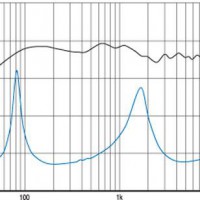The Morchellas
Designer: Darren Kuzma
Project Time: 8-20 hours
Project Complexity: Hobbyist
Project Cost: $100-$500
Driver Selection
Starting with the woofer, I was immediately intrigued by the new Morel Hybrid series of drivers. They offer a good combination of specs and performance, and sell at what I would consider the upper end of the mid-priced drivers. From doing some quick modeling of the parameters, I liked the looks on paper of the H6.1 6″ driver. It has specs to make it work well in a mid-size vented enclosure, and has a very good sensitivity compared to other drivers of its size. Cosmetically it is very attractive and uses a coated DPC cone, large rubber surround, and nice lowstray- field neo/ceramic motor. I did some quick measurements of the frequency response, which offered a clean response up to 2 kHz, and the parameters matched Morel’s specs fairly well. The H 6.1 looked like a good choice. Since we were using a relatively high-end woofer, I knew that I wanted to start looking at Morel’s higher-end tweeter offerings. I have used the MDT-30 before and know that it is a very nice tweeter, so I wanted to use something similar but perhaps a little better suited for this design. I did not need ultra-high sensitivity or ultra-high power handling, and since the H6.1 is essentially shielded, a neodymium tweeter would be good choice. The MDT-39 seemed the perfect balance of cost versus performance; with everything I needed including the shielding without too many superfluous features.
Enclosure Design
Since this is what I would consider a high-end design, this project was a great opportunity to use one of the Parts Express finished speaker cabinets. Based on the parameters of the driver, the .50 cu. ft. enclosure was just about the perfect size. If you wanted to build your own cabinet, the dimensions would be 14″ tall, 8.5″ wide, and 12″ deep, when made out of 3/4″ MDF. This enclosure was tuned to approximately 48 Hz with a 2″ diameter by 5″ long port. The woofer and tweeter were centered on the baffle both horizontally and vertically, with a small center-to-center spacing of just 4-1/2″.
Amplifier/Crossover Configuration
I knew from my preliminary measurements of the H6.1 and from my knowledge of the MDT-39 tweeter that I should probably shoot for a crossover point of about 2 kHz. This would take advantage of the smoothest region of the woofer, and maintain excellent off-axis response in the midrange. The woofer and tweeter both took very well to simple 2nd order electrical crossovers, with the woofer needing an impedance compensation network. Both the high and low-pass have a quasi-third-order acoustic cutoff, crossing each other at about 2 kHz. The result is a crossover with minimal parts count, and a frequency response that has a bit of a “BBC dip”, meaning that the response is down a couple dB between 1.5 kHz and 5 kHz.. This slight depression in the midrange creates a more relaxed sounding speaker that seems fuller at lower playback levels.
Enclosure Assembly
Since I used a pre-built and pre-finished cabinet, I thought that this would be an excellent time to talk about some of the tricks for flushmounting non-round drivers. First, let’s look at how to flush-mount the Morel MDT-39 (which would be the same recess as for the MDT-12, MDT-22, MDT-40, or MDT-44). This tweeter measures 2-1/8″ square, and has approximately a 1/4″ radius on the corners. So, we can cut the flush-mount with a 1/2″ diameter straight cutting bit, and utilize a collet and wooden template. Wanting to use the smallest collet possible, a 5/8″ OD size provides just the clearance for the bit that to make, plus makes it easy to figure out what size template we need. Since the collet adds 1/16″ on either side of the bit, we simply need to add 1/8″ to the 2-1/8″ flange size; hence the template should be a 2-1/4″ square. (See the PE website for my tips on how to quickly and accurately make the template). Once we have the template, it is simply a matter of setting the correct bit depth, securing the template in place on the surface of the baffle, and then tracing inside the template with your router. A perfect square-with rounded- corners every time! The woofer flush-mount was done with the Jasper Circle Jig Model 200. To get ready to make the cut, we need to drill a 1/8″ diameter hole at the center of the woofer location. Adjust the plunge router stop to the proper depth, which in this case is 1/4″. Insert the Jasper center pivot pin at the desired diameter, 6-5/16″ for this particular woofer, and then place the pivot pin down into the woofer center hole on the baffle. Make a couple passes with the router to create the recess for the flange, and then make the cut through the baffle for the woofer. This can be done with the Jasper Jig itself, or can be done freehand with a sabre saw.
Conclusion
Since one of my main goals was to try out a couple Morel items that I have never used before, I will start with some thoughts on the individual driver performance. Based on its use in this system, I would say that the MDT-39 is one of the best values in high-end tweeters. It offers an extremely clean and smooth sound, is magnetically shielded, can handle low crossover points, and has a very good build quality. At $45.00, once you get around the mounting issues, there shouldn’t be any reason not to use this tweeter. The H6.1 is certainly no slouch as far as woofers go, but at a more costly $90.00, I don’t think it is quite the bargain of the MDT-39. One positive trait of this driver is that it does not suffer from any large breakup peaks, allowing it to be used without any complicated and costly notch filters in the crossover. Perhaps its best feature is its high sensitivity; I measured it at just under 90 dB through most of its region, compared to 85-87 dB for most other 6-1/2″ drivers. The extra sensitivity gives it a very dynamic presence, and would allow this driver to be used with low-power amplifiers. Overall, I am very pleased with the performance of this speaker system. Thanks to its relatively high sensitivity, about 88 dB with 1 watt, it gives a good sense of a bigsounding speaker in a small package. The bass is somewhat limited on low-end extension, only playing solidly down to the mid-50 Hz region, but this fills in very well if used near a wall or in a smallish room. Imaging capabilities are very good, and this speaker produces a very live, dynamic sound. All in all, this speaker has a very different sound than last months Jubilees, being more aggressive and lively, and with a noticeably higher sensitivity. If you like British monitor-style speakers that are dynamic and engaging, these are the speakers for you.
About The Designer
Darren Kuzma is a long-time speaker-building hobbyist who is known for his often unusual and unorthodox designs. Despite the fact that he often chooses unconventional enclosures or configurations, the speakers nevertheless deliver consistently good sound. Darren was an employee of Parts Express, where he was the Product Manager of the Speaker Building Products and he also moderated the Tech Talk board.
Project Parts List
|
Part # |
Description |
Qty |
|
297-064 |
1 |
|
|
277-035 |
1 |
|
|
027-425 |
1 |
|
|
027-428 |
1 |
|
|
005-4 |
1 |
|
|
004-8 |
Dayton Audio DNR-8.0 8 Ohm 10W Precision Audio Grade Resisto |
1 |
|
255-426 |
1 |
|
|
255-230 |
1 |
|
|
091-1247 |
1 |
|
|
302-724 |
1 |
|
|
260-387 |
1 |
|
|
260-840 |
1 |
|
|
260-535 |
Sonic Barrier 1-1/4″ 3-Layer Damping Material w/PSA 18 x 24″ |
1 |
|
260-540 |
1 |





+ There are no comments
Add yours